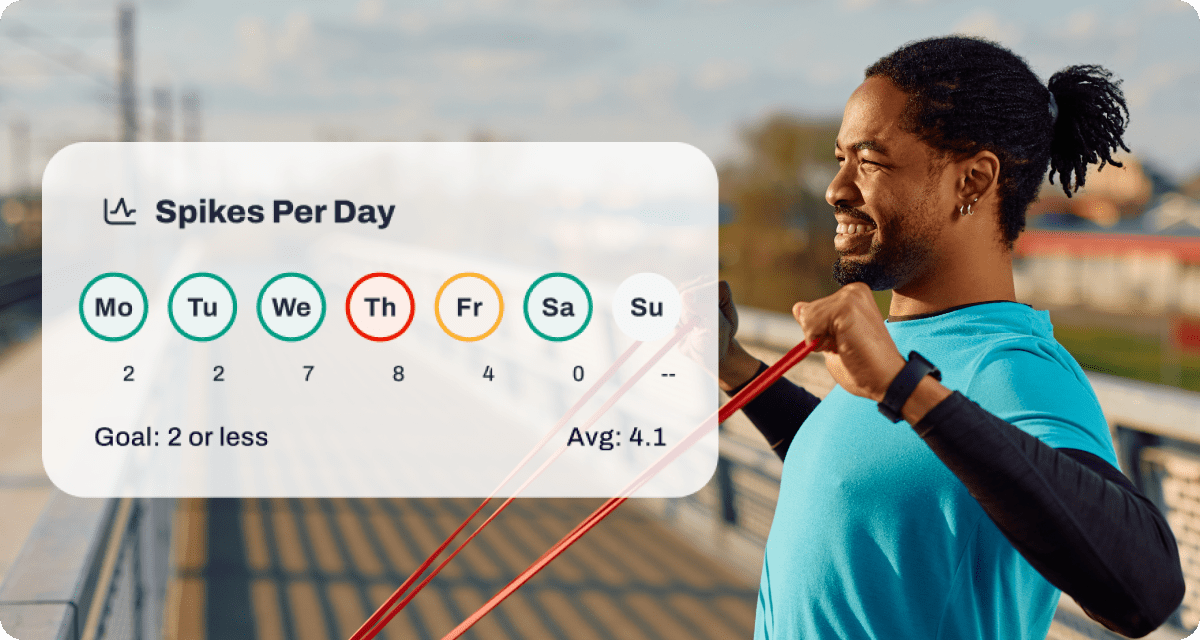Research shows that men are less likely than women to engage in self-care activities, taking pride in their strength and ability to push through rather than slowing down to recharge.1 It’s not just facials, pedicures, and therapy that most men take a hard pass on; they are also skipping out on going to the doctor.1 Not only do men see healthcare providers less frequently than women, but they are also less likely to be honest about their symptoms when they do talk to their physician.2
Early signs of metabolic dysfunction can be easy to dismiss and may not seem worth mentioning during an annual physical. Symptoms like stubborn weight gain, low motivation, brain fog, and sleep issues can vary in severity and be due to a number of lifestyle factors. Yet these subtle changes can indicate underlying insulin resistance, hormonal imbalance, and cardiovascular issues. Left unchecked, these concerns can progress into type 2 diabetes, hypertension, and heart disease, which is the leading cause of death among men in the U.S.3
The good news is these early “red flags” are reversible. With the right nutrition, physical activity, and data-driven insights from tools like Signos, men can identify metabolic stress early and prevent long-term health complications.
Subtle Symptoms Men Often Overlook

The early stages of metabolic dysfunction often look like everyday stress. But it’s important to pay attention to your health patterns. If any of these signs persist, it’s time to listen to your body and talk to your healthcare provider:
- Persistent fatigue or low energy: Frequent glucose fluctuations cause energy crashes, forcing your body into a stress-response cycle that drains stamina.
- Stubborn abdominal fat: Especially around the waistline. Visceral fat is metabolically active and linked to insulin resistance and elevated triglycerides.4
- Reduced libido: Low testosterone can be both a cause and effect of poor metabolic health, as fat tissue converts testosterone to estrogen.5
- Sleep disruption: Elevated cortisol and poor glucose regulation alter circadian rhythm, reducing recovery and causing even more metabolic stress.
- Brain fog and mood changes: Inflammation and unstable blood glucose levels impair focus and neurotransmitter balance.6
Why These Signs Matter

These symptoms reflect deeper changes in insulin sensitivity and the way your cells use energy. Over time, these shifts can lead to metabolic syndrome, which is a cluster of risk factors that includes:7
- Elevated fasting glucose
- High triglycerides
- Low HDL (“good”) cholesterol levels
- Increased waist circumference
- High blood pressure (≥130/85 mmHg)
Men with three or more of these criteria have a significantly higher risk of obesity, type 2 diabetes mellitus, and cardiovascular disease. What’s often missed is that this dysfunction starts years before diagnosis. The silver lining is that catching this early and making the right lifestyle adjustments can still reverse the course of these conditions.
The Hidden Link Between Blood Sugar and Heart Health
Blood sugar and heart health are more connected than most people realize. Chronically high postprandial glucose levels (after-meal blood sugar spikes) damage the delicate lining of blood vessels and accelerate atherosclerosis. Elevated insulin levels are also harmful as they trigger the liver to produce more VLDL cholesterol, raising triglyceride levels while reducing HDL. Over time, this combination increases cardiovascular risk even in men who appear “fit.”8
Continuous glucose monitoring (CGM) systems like Signos can reveal how your daily meals affect both energy and vascular health in real time, enabling proactive corrections before serious damage occurs.
5 Lifestyle Factors That Contribute

Metabolic decline isn’t caused by just one thing; it’s the cumulative effect of lifestyle habits that quietly erode insulin sensitivity and promote inflammation:
- Processed foods and refined carbohydrates: Frequent glucose spikes from these foods cause the pancreas to overproduce insulin, leading to long-term resistance.
- Low physical activity: Sedentary behavior reduces glucose uptake in muscles, leading to higher blood sugar levels even when you're not eating.
- Chronic stress: Constant cortisol elevation increases abdominal body fat, raises blood pressure, and increases insulin resistance.9
- Poor sleep quality: Even one night of inadequate sleep reduces insulin sensitivity. Men who sleep less than 6 hours per night are almost twice as likely to develop diabetes compared to men who get more sleep.10
- Alcohol and tobacco: Men have higher levels of alcohol consumption than women.1 Both alcohol and tobacco can impair liver function, disrupt lipid metabolism, and increase oxidative stress.
Over time, these choices combine to alter energy balance, reduce muscle mass, and wreak havoc on the metabolism.
4 Actionable Steps to Protect Metabolic Health

1. Fuel Smarter
Replace refined carbs with whole grains, healthy proteins, and fiber-rich foods that slow glucose absorption and stabilize blood sugar. Prioritize omega-3 fats (salmon, flax, walnuts), lower triglycerides, and reduce inflammation.
2. Move Often (Especially After Meals)
Even a 10-minute walk after eating can help your muscles absorb glucose and lower the demand on your pancreas for insulin. Mix resistance training (to build muscle mass) with cardio for optimal fat metabolism and weight loss benefits.11
3. Manage Stress and Sleep
Mind-body practices such as deep breathing, yoga, or spending time in nature reduce cortisol and support recovery. Establish a consistent bedtime routine and aim for 7–9 hours of sleep to maintain hormonal balance.
4. Track Progress and Get Screened
Request labs that include fasting glucose, HbA1c, cholesterol, triglycerides, and blood pressure readings. These markers reflect early metabolic changes that can be reversed with lifestyle changes.
How Signos Helps Men Stay Ahead
Don’t guess when it comes to your health and metabolism, measure it. With a CGM and smart analytics, Signos turns everyday data into clear, actionable insights about how your body responds to food, stress, sleep, and training load.
What Signos Tracks That Matter for Men’s Metabolic Health

- Continuous Glucose Monitoring (CGM): See real-time fluctuations that might signal reduced insulin sensitivity, such as higher-than-normal fasting glucose, sharper post-meal spikes, or slow returns to baseline after heavy meals or late-night eating.
- Personalized Meal and Workout Responses: Signos shows how your body handles a protein-forward breakfast vs. a carb-heavy one, or how weight training vs. steady-state cardio affects your glucose recovery and energy for the rest of the day.
- Stress and Sleep-Driven Patterns: Poor sleep, high work stress, or overtraining can elevate glucose even without food. The app helps you track these connections so you can adjust before energy dips or cravings kick in.
- Long-Term Trend Analysis: Spot early red flags: rising morning glucose, growing variability, or declining metabolic stability over weeks. Seeing trends helps men understand whether their routines are building resilience or straining their metabolism.
- Real-Time Nudges: Signos delivers timely prompts: movement after a high-glucose meal, eating windows that support insulin sensitivity, or hydration suggestions when glucose drifts up unexpectedly.
Experiments Men Can Try in the Signos App
These practical tests help uncover personal metabolic weaknesses and identify what improves them:
- Protein-to-Carb Ratio Test: Track the same meal with different protein amounts to see whether increasing protein blunts spikes and improves satiety.
- Strength vs. Cardio Recovery Experiment: Compare post-workout glucose after a heavy lifting session versus a cardio day. A prolonged elevation may signal fatigue, poor recovery, or higher stress load.
- Visceral Fat Indicator Check: Monitor post-meal spikes after higher-fat meals versus balanced ones. Repeated sharp spikes can hint at increased visceral fat or reduced insulin sensitivity.
- Late-Night Meal Impact: Test a typical dinner earlier vs. later. If the later meal produces a bigger spike or slower decline, that’s a common metabolic red flag for men.
- Stress-Day vs. Rest-Day Comparison: Tag a stressful day and observe whether glucose drifts upward even with normal eating. This experiment highlights how cortisol (already higher in chronically stressed men) affects metabolic function.
The Bottom Line
Metabolic red flags don’t appear overnight; the body often whispers long before it shouts. Pay attention to small changes like fatigue, stubborn belly fat, and mood dips. Recognizing these patterns early can allow you to act before prediabetes or hypertension takes hold. With balanced nutrition, consistent physical activity, and Signos’s real-time metabolic insights, men can build stronger, leaner, and longer-lasting health from the inside out.
Learn More With Signos’ Expert Advice
Signos combines cutting-edge research with the proven benefits of continuous glucose monitoring to help you achieve your health goals. Check out more articles on the Signos blog.
Topics discussed in this article:
References
- Narasimhan, M., Logie, C.H., Moody, K. et al. The role of self-care interventions on men’s health-seeking behaviours to advance their sexual and reproductive health and rights. Health Res Policy Sys 19, 23 (2021). https://doi.org/10.1186/s12961-020-00655-0
- https://www.heart.org/en/news/2021/06/15/misguided-masculinity-keeps-many-men-from-visiting-the-doctor
- Centers for Disease Control and Prevention. Leading causes of death in males, United States. CDC National Center for Health Statistics. Published 2023.
- Després JP. Body fat distribution and risk of cardiovascular disease: an update. Circulation. 2012;126(10):1301-1313. doi:10.1161/CIRCULATIONAHA.111.067264
- Muraleedharan V, Jones TH. Testosterone and the metabolic syndrome. Ther Adv Endocrinol Metab. 2010;1(5):207-223. doi:10.1177/2042018810390258
- Dantzer R, et al. From inflammation to sickness and depression. Nat Rev Neurosci. 2008;9(1):46-56. doi:10.1038/nrn2297
- Alberti KGMM, et al. Harmonizing the metabolic syndrome: definition and worldwide prevalence. Circulation. 2009;120(16):1640-1645. doi:10.1161/CIRCULATIONAHA.109.192644
- Ceriello A, et al. Postprandial hyperglycemia and cardiovascular complications. Diabetes. 2008;57(1):14-17. doi:10.2337/db08-1310
- Rosmond R. Role of stress in the pathogenesis of the metabolic syndrome. Psychoneuroendocrinology. 2005;30(1):1-10. doi:10.1016/j.psyneuen.2004.05.007
- Knutson KL. Impact of sleep and sleep loss on glucose homeostasis and appetite regulation. Sleep Med Clin. 2007;2(2):187-197. doi:10.1016/j.jsmc.2007.03.004
- Colberg SR, et al. Physical activity and diabetes: a position statement of the ADA. Diabetes Care. 2016;39(11):2065-2079. doi:10.2337/dc16-1728




.svg)










.svg)
.svg)
.svg)
.svg)
.svg)
.svg)
.svg)
